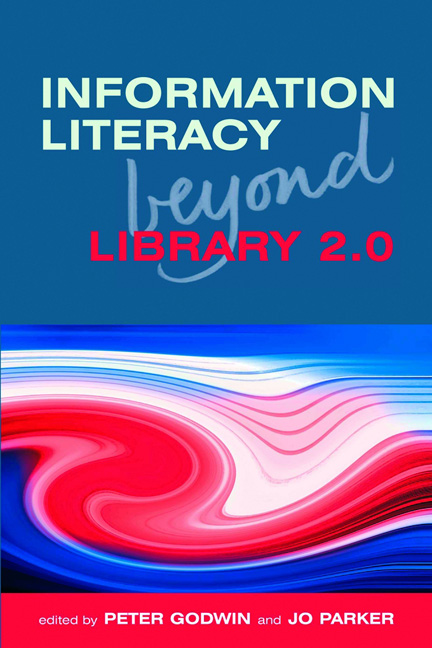Book contents
- Frontmatter
- Contents
- Contributors
- Acknowledgements
- Introduction
- PART 1 RECENT DEVELOPMENTS IN INFORMATION LITERACY AND LIBRARY 2.0
- 1 Library 2.0: a retrospective
- 2 Information literacy and Library 2.0: an update
- 3 The story so far: progress in Web 2.0 and information literacy
- 4 The changing web: sites to social
- 5 Web 2.0: from information literacy to transliteracy
- 6 Informed learning in online environments: supporting the higher education curriculum beyond Web 2.0
- PART 2 CASE STUDIES
- PART 3 WHAT IT MEANS FOR INFORMATION PROFESSIONALS
- Index
1 - Library 2.0: a retrospective
from PART 1 - RECENT DEVELOPMENTS IN INFORMATION LITERACY AND LIBRARY 2.0
Published online by Cambridge University Press: 09 June 2018
- Frontmatter
- Contents
- Contributors
- Acknowledgements
- Introduction
- PART 1 RECENT DEVELOPMENTS IN INFORMATION LITERACY AND LIBRARY 2.0
- 1 Library 2.0: a retrospective
- 2 Information literacy and Library 2.0: an update
- 3 The story so far: progress in Web 2.0 and information literacy
- 4 The changing web: sites to social
- 5 Web 2.0: from information literacy to transliteracy
- 6 Informed learning in online environments: supporting the higher education curriculum beyond Web 2.0
- PART 2 CASE STUDIES
- PART 3 WHAT IT MEANS FOR INFORMATION PROFESSIONALS
- Index
Summary
When Information Literacy Meets Library 2.0 was written in 2008 it was still ‘cool’ to use the 2.0 epithet. We did not attempt detailed definitions and skirted over any distinctions between Web 2.0 and Library 2.0. Now that the general enthusiasm has died down and scepticism about its merits has surfaced, we need to examine what it was all about in the first place and how it has turned out in practice. We shall see that there has been widespread adoption of certain elements of the 2.0 bandwagon, particularly in awareness, if not in the practice of all librarians. The importance of 2.0 in connecting to the so-called Net Generation was overplayed. The CIBER reports (2008) have demonstrated that the ‘geeks’ were in the minority. Now that the bubble has burst, we can begin to appreciate that social media (aka Web 2.0 tools) are here to stay. They have now become mainstream.
What was Web 2.0 and Library 2.0 about?
In 2004 something fundamental happened to the world wide web. It became a place for collaboration, more personal and driven by us, the users. The web itself, not extra software that had to be downloaded, became our platform and made it possible for us to share our thoughts, photos and videos and build or take part in building websites easily. The availability of the easy-to-use web tools for creating blogs and wikis and engaging in social networking seemed especially appealing to the young. This led university staff too, including librarians, to realize that it could be advantageous to start using them, both for plugging into their users’ wavelength and for their marketing and educational potential. Then Michael Casey in his blog Library Crunch came up with the term Library 2.0, seeing it as a user-centred environment that helped people to learn and to fulfil their information needs and that also encouraged them to both create and share content (Sodt and Summey, 2009): ‘Library 2.0 will look different for each library, based in part on users’ diverse needs’ (Casey and Savastinuk, 2007, 37). Library 2.0 was about constant change brought about through evaluation to see whether we were meeting our expected outcomes. It was about user participation, feedback and reaching out to new and existing users (Casey and Savastinuk, 2007). Brian McManus (2009) uses Web 2.0 and Library 2.0 interchangeably, and this has usually been my own approach.
- Type
- Chapter
- Information
- Information Literacy Beyond Library 2.0 , pp. 3 - 18Publisher: FacetPrint publication year: 2012
- 3
- Cited by



